Travel and Tourism Marketing: Swiss International Airline Report
VerifiedAdded on 2023/01/12
|9
|2410
|58
Report
AI Summary
This report provides an in-depth analysis of the marketing strategies employed by Swiss International Airlines within the travel and tourism industry. It begins with an introduction to the importance of marketing in the airline sector, emphasizing its role in attracting customers and contributing to economic growth. The main body of the report explores how Swiss International Airlines segments its customer base using demographic, psychographic, behavioral, and geographic segmentation methods. It then examines the various target marketing strategies adopted by the company, including undifferentiated, differentiated, focused, and customized marketing approaches. Furthermore, the report delves into the positioning strategies utilized by Swiss International Airlines, such as product attribute, price, quality, use/application, and competitor-based positioning. The importance of positioning in creating a unique brand identity and driving organizational success is also discussed. The report concludes by summarizing the key findings and reiterating the significance of effective marketing strategies in the competitive airline industry. The report is a valuable resource for students seeking to understand marketing principles and their application in the travel and tourism sector, specifically within the context of airline operations.
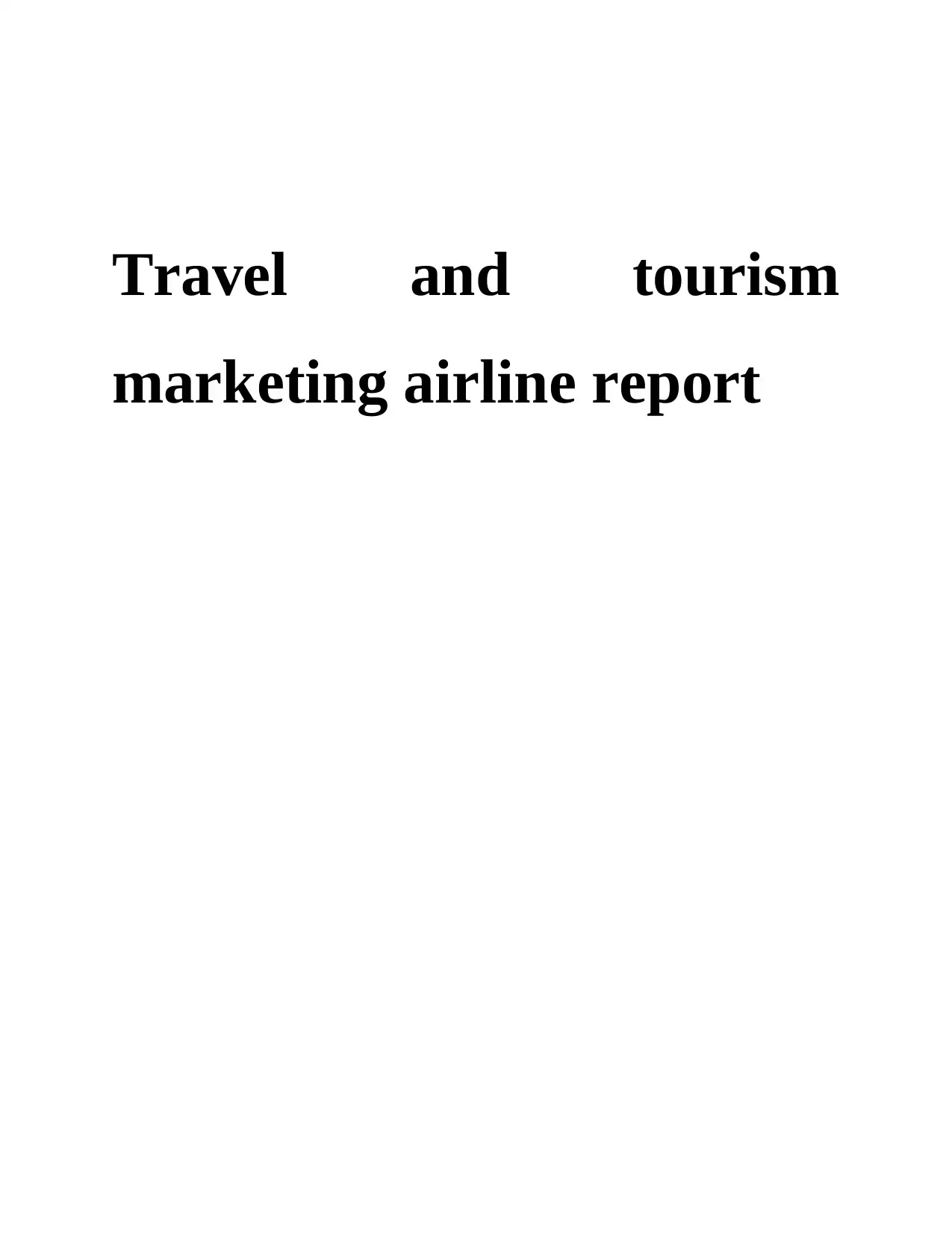
Travel and tourism
marketing airline report
marketing airline report
Paraphrase This Document
Need a fresh take? Get an instant paraphrase of this document with our AI Paraphraser
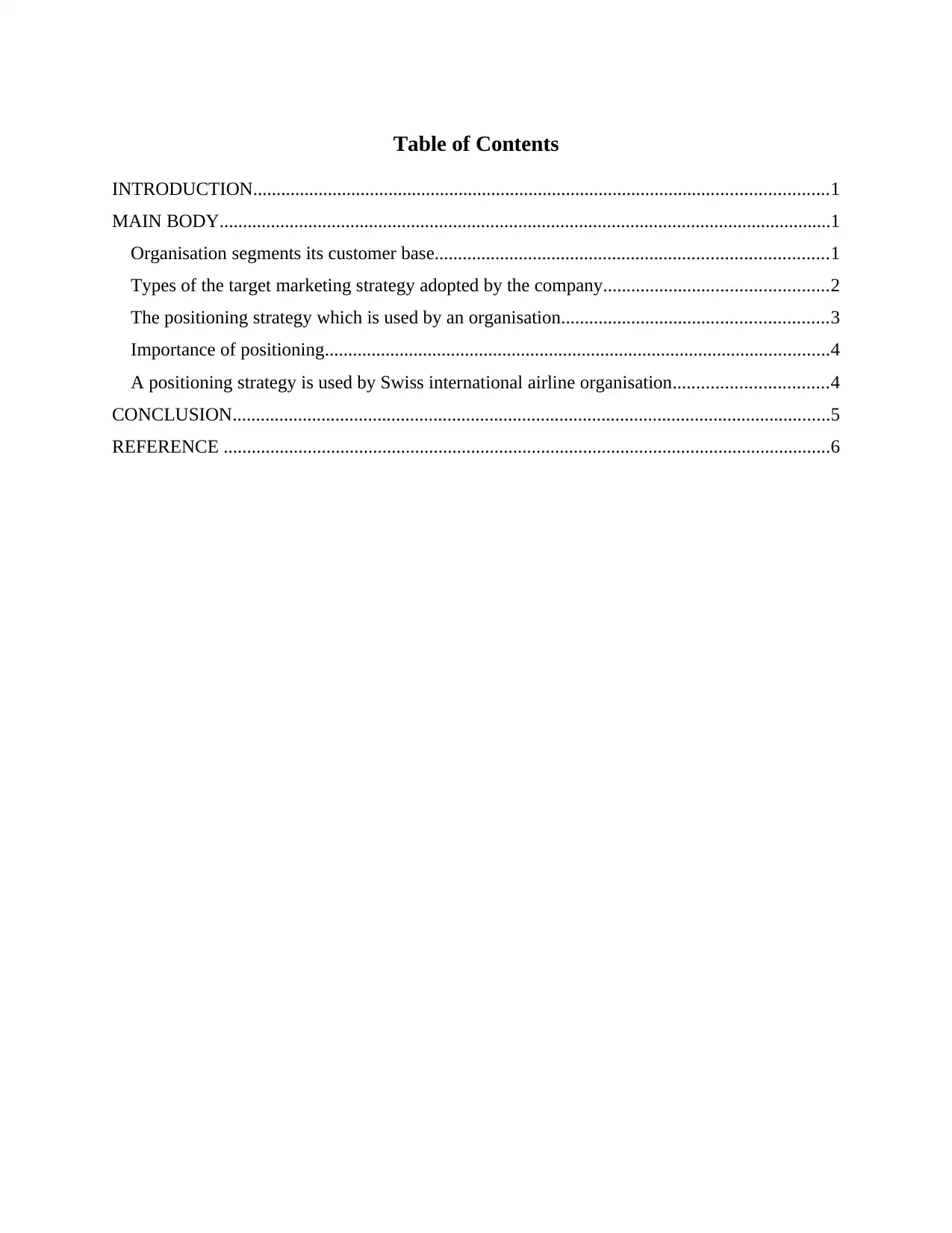
Table of Contents
INTRODUCTION...........................................................................................................................1
MAIN BODY...................................................................................................................................1
Organisation segments its customer base....................................................................................1
Types of the target marketing strategy adopted by the company................................................2
The positioning strategy which is used by an organisation.........................................................3
Importance of positioning............................................................................................................4
A positioning strategy is used by Swiss international airline organisation.................................4
CONCLUSION................................................................................................................................5
REFERENCE ..................................................................................................................................6
INTRODUCTION...........................................................................................................................1
MAIN BODY...................................................................................................................................1
Organisation segments its customer base....................................................................................1
Types of the target marketing strategy adopted by the company................................................2
The positioning strategy which is used by an organisation.........................................................3
Importance of positioning............................................................................................................4
A positioning strategy is used by Swiss international airline organisation.................................4
CONCLUSION................................................................................................................................5
REFERENCE ..................................................................................................................................6

⊘ This is a preview!⊘
Do you want full access?
Subscribe today to unlock all pages.

Trusted by 1+ million students worldwide
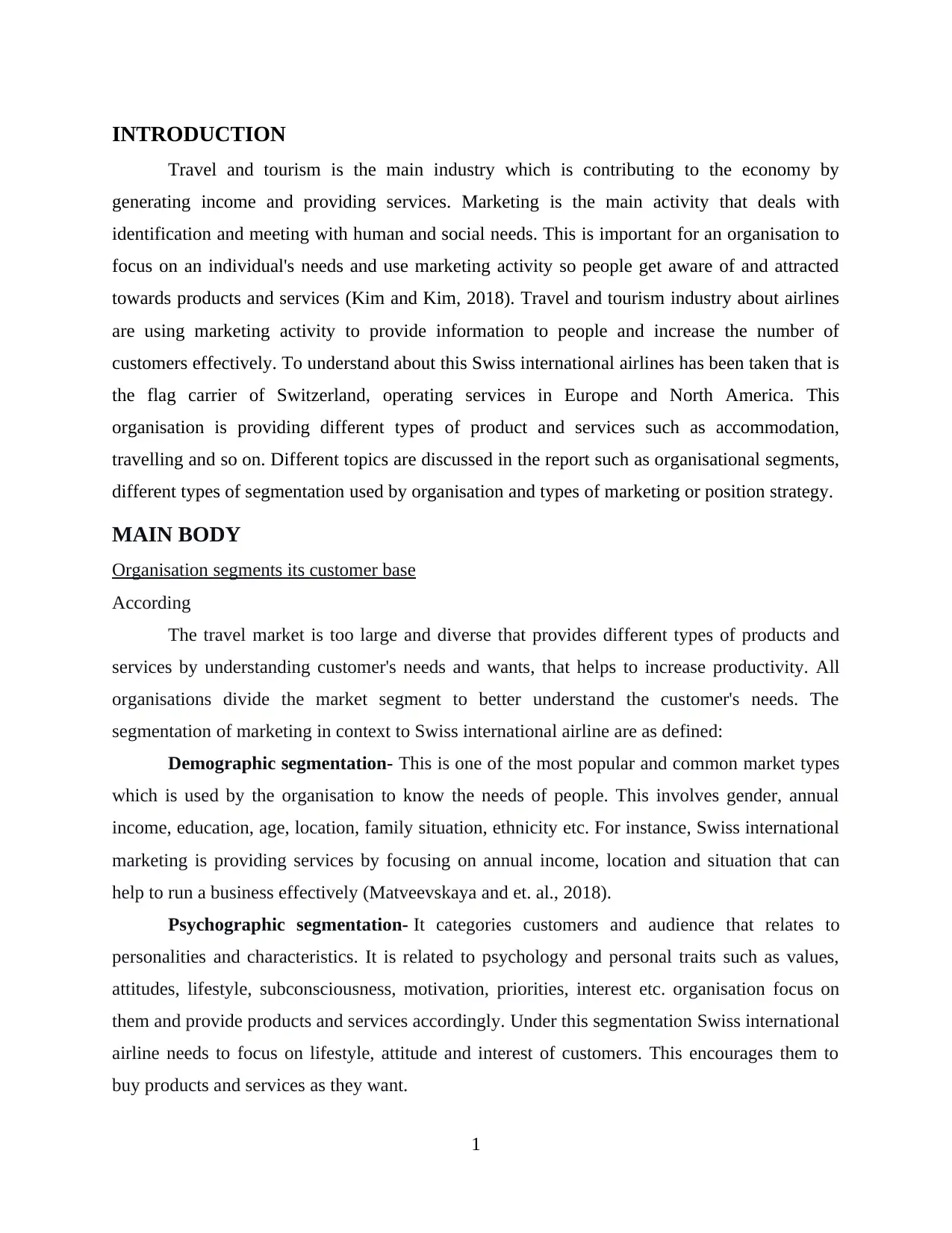
INTRODUCTION
Travel and tourism is the main industry which is contributing to the economy by
generating income and providing services. Marketing is the main activity that deals with
identification and meeting with human and social needs. This is important for an organisation to
focus on an individual's needs and use marketing activity so people get aware of and attracted
towards products and services (Kim and Kim, 2018). Travel and tourism industry about airlines
are using marketing activity to provide information to people and increase the number of
customers effectively. To understand about this Swiss international airlines has been taken that is
the flag carrier of Switzerland, operating services in Europe and North America. This
organisation is providing different types of product and services such as accommodation,
travelling and so on. Different topics are discussed in the report such as organisational segments,
different types of segmentation used by organisation and types of marketing or position strategy.
MAIN BODY
Organisation segments its customer base
According
The travel market is too large and diverse that provides different types of products and
services by understanding customer's needs and wants, that helps to increase productivity. All
organisations divide the market segment to better understand the customer's needs. The
segmentation of marketing in context to Swiss international airline are as defined:
Demographic segmentation- This is one of the most popular and common market types
which is used by the organisation to know the needs of people. This involves gender, annual
income, education, age, location, family situation, ethnicity etc. For instance, Swiss international
marketing is providing services by focusing on annual income, location and situation that can
help to run a business effectively (Matveevskaya and et. al., 2018).
Psychographic segmentation- It categories customers and audience that relates to
personalities and characteristics. It is related to psychology and personal traits such as values,
attitudes, lifestyle, subconsciousness, motivation, priorities, interest etc. organisation focus on
them and provide products and services accordingly. Under this segmentation Swiss international
airline needs to focus on lifestyle, attitude and interest of customers. This encourages them to
buy products and services as they want.
1
Travel and tourism is the main industry which is contributing to the economy by
generating income and providing services. Marketing is the main activity that deals with
identification and meeting with human and social needs. This is important for an organisation to
focus on an individual's needs and use marketing activity so people get aware of and attracted
towards products and services (Kim and Kim, 2018). Travel and tourism industry about airlines
are using marketing activity to provide information to people and increase the number of
customers effectively. To understand about this Swiss international airlines has been taken that is
the flag carrier of Switzerland, operating services in Europe and North America. This
organisation is providing different types of product and services such as accommodation,
travelling and so on. Different topics are discussed in the report such as organisational segments,
different types of segmentation used by organisation and types of marketing or position strategy.
MAIN BODY
Organisation segments its customer base
According
The travel market is too large and diverse that provides different types of products and
services by understanding customer's needs and wants, that helps to increase productivity. All
organisations divide the market segment to better understand the customer's needs. The
segmentation of marketing in context to Swiss international airline are as defined:
Demographic segmentation- This is one of the most popular and common market types
which is used by the organisation to know the needs of people. This involves gender, annual
income, education, age, location, family situation, ethnicity etc. For instance, Swiss international
marketing is providing services by focusing on annual income, location and situation that can
help to run a business effectively (Matveevskaya and et. al., 2018).
Psychographic segmentation- It categories customers and audience that relates to
personalities and characteristics. It is related to psychology and personal traits such as values,
attitudes, lifestyle, subconsciousness, motivation, priorities, interest etc. organisation focus on
them and provide products and services accordingly. Under this segmentation Swiss international
airline needs to focus on lifestyle, attitude and interest of customers. This encourages them to
buy products and services as they want.
1
Paraphrase This Document
Need a fresh take? Get an instant paraphrase of this document with our AI Paraphraser
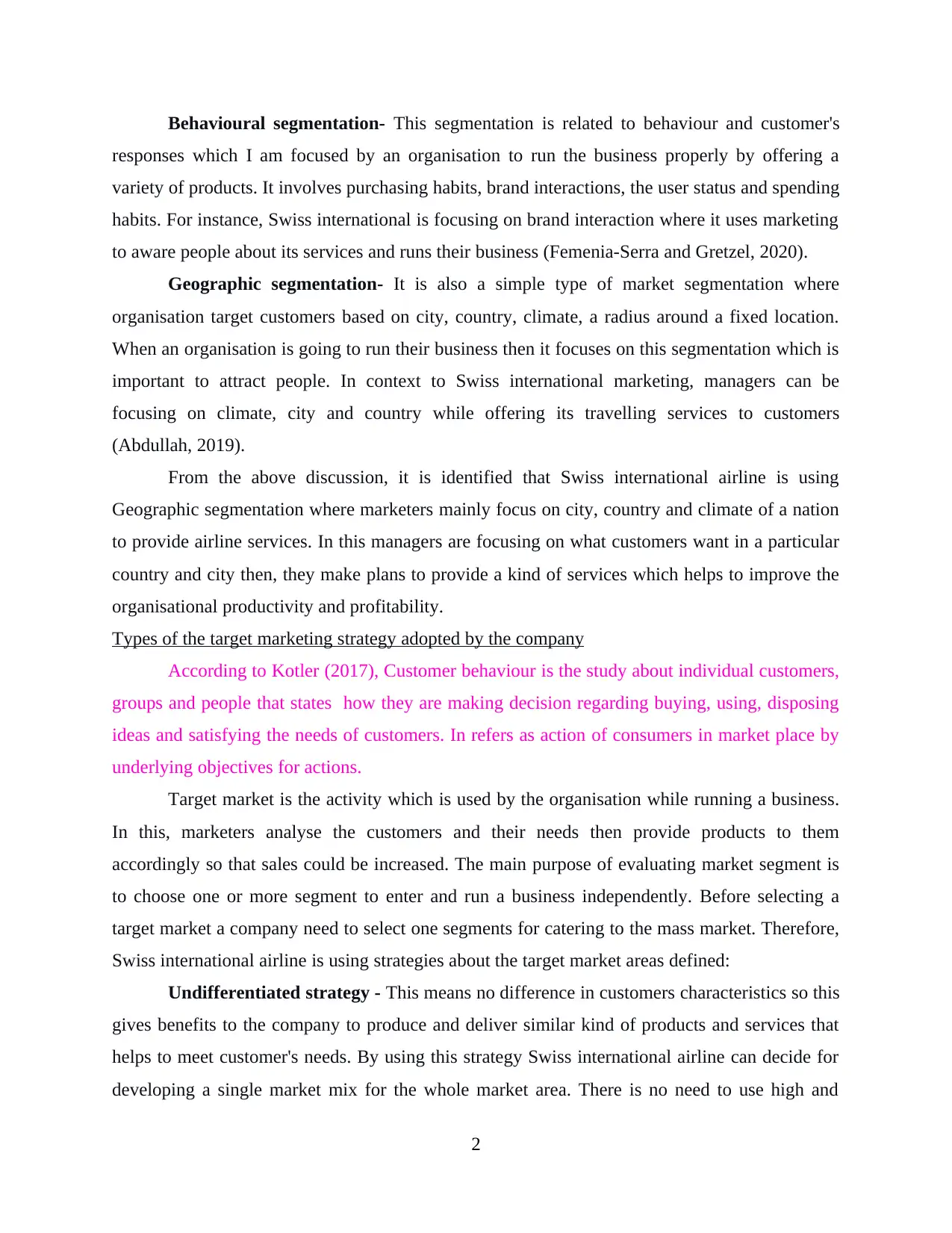
Behavioural segmentation- This segmentation is related to behaviour and customer's
responses which I am focused by an organisation to run the business properly by offering a
variety of products. It involves purchasing habits, brand interactions, the user status and spending
habits. For instance, Swiss international is focusing on brand interaction where it uses marketing
to aware people about its services and runs their business (Femenia-Serra and Gretzel, 2020).
Geographic segmentation- It is also a simple type of market segmentation where
organisation target customers based on city, country, climate, a radius around a fixed location.
When an organisation is going to run their business then it focuses on this segmentation which is
important to attract people. In context to Swiss international marketing, managers can be
focusing on climate, city and country while offering its travelling services to customers
(Abdullah, 2019).
From the above discussion, it is identified that Swiss international airline is using
Geographic segmentation where marketers mainly focus on city, country and climate of a nation
to provide airline services. In this managers are focusing on what customers want in a particular
country and city then, they make plans to provide a kind of services which helps to improve the
organisational productivity and profitability.
Types of the target marketing strategy adopted by the company
According to Kotler (2017), Customer behaviour is the study about individual customers,
groups and people that states how they are making decision regarding buying, using, disposing
ideas and satisfying the needs of customers. In refers as action of consumers in market place by
underlying objectives for actions.
Target market is the activity which is used by the organisation while running a business.
In this, marketers analyse the customers and their needs then provide products to them
accordingly so that sales could be increased. The main purpose of evaluating market segment is
to choose one or more segment to enter and run a business independently. Before selecting a
target market a company need to select one segments for catering to the mass market. Therefore,
Swiss international airline is using strategies about the target market areas defined:
Undifferentiated strategy - This means no difference in customers characteristics so this
gives benefits to the company to produce and deliver similar kind of products and services that
helps to meet customer's needs. By using this strategy Swiss international airline can decide for
developing a single market mix for the whole market area. There is no need to use high and
2
responses which I am focused by an organisation to run the business properly by offering a
variety of products. It involves purchasing habits, brand interactions, the user status and spending
habits. For instance, Swiss international is focusing on brand interaction where it uses marketing
to aware people about its services and runs their business (Femenia-Serra and Gretzel, 2020).
Geographic segmentation- It is also a simple type of market segmentation where
organisation target customers based on city, country, climate, a radius around a fixed location.
When an organisation is going to run their business then it focuses on this segmentation which is
important to attract people. In context to Swiss international marketing, managers can be
focusing on climate, city and country while offering its travelling services to customers
(Abdullah, 2019).
From the above discussion, it is identified that Swiss international airline is using
Geographic segmentation where marketers mainly focus on city, country and climate of a nation
to provide airline services. In this managers are focusing on what customers want in a particular
country and city then, they make plans to provide a kind of services which helps to improve the
organisational productivity and profitability.
Types of the target marketing strategy adopted by the company
According to Kotler (2017), Customer behaviour is the study about individual customers,
groups and people that states how they are making decision regarding buying, using, disposing
ideas and satisfying the needs of customers. In refers as action of consumers in market place by
underlying objectives for actions.
Target market is the activity which is used by the organisation while running a business.
In this, marketers analyse the customers and their needs then provide products to them
accordingly so that sales could be increased. The main purpose of evaluating market segment is
to choose one or more segment to enter and run a business independently. Before selecting a
target market a company need to select one segments for catering to the mass market. Therefore,
Swiss international airline is using strategies about the target market areas defined:
Undifferentiated strategy - This means no difference in customers characteristics so this
gives benefits to the company to produce and deliver similar kind of products and services that
helps to meet customer's needs. By using this strategy Swiss international airline can decide for
developing a single market mix for the whole market area. There is no need to use high and
2
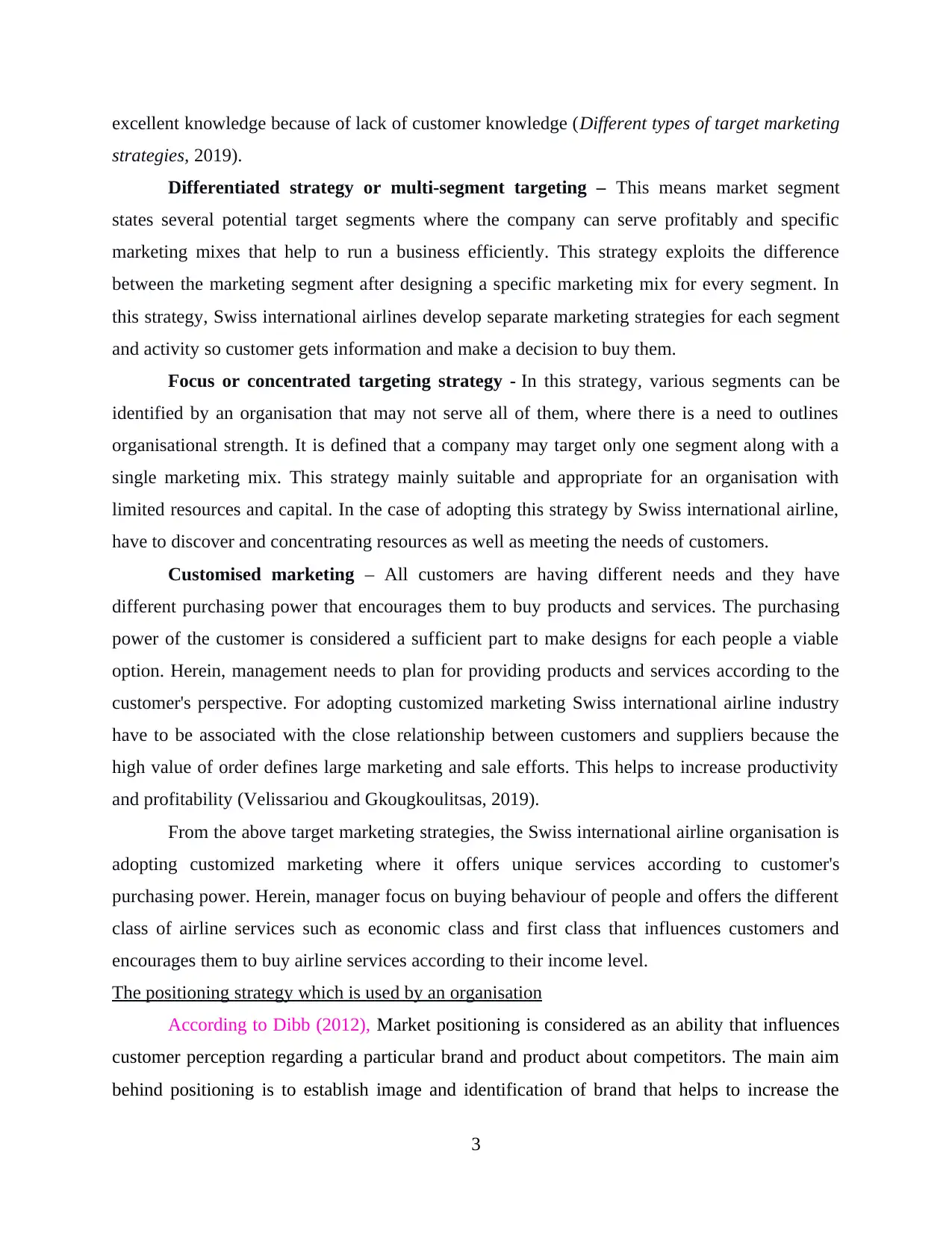
excellent knowledge because of lack of customer knowledge (Different types of target marketing
strategies, 2019).
Differentiated strategy or multi-segment targeting – This means market segment
states several potential target segments where the company can serve profitably and specific
marketing mixes that help to run a business efficiently. This strategy exploits the difference
between the marketing segment after designing a specific marketing mix for every segment. In
this strategy, Swiss international airlines develop separate marketing strategies for each segment
and activity so customer gets information and make a decision to buy them.
Focus or concentrated targeting strategy - In this strategy, various segments can be
identified by an organisation that may not serve all of them, where there is a need to outlines
organisational strength. It is defined that a company may target only one segment along with a
single marketing mix. This strategy mainly suitable and appropriate for an organisation with
limited resources and capital. In the case of adopting this strategy by Swiss international airline,
have to discover and concentrating resources as well as meeting the needs of customers.
Customised marketing – All customers are having different needs and they have
different purchasing power that encourages them to buy products and services. The purchasing
power of the customer is considered a sufficient part to make designs for each people a viable
option. Herein, management needs to plan for providing products and services according to the
customer's perspective. For adopting customized marketing Swiss international airline industry
have to be associated with the close relationship between customers and suppliers because the
high value of order defines large marketing and sale efforts. This helps to increase productivity
and profitability (Velissariou and Gkougkoulitsas, 2019).
From the above target marketing strategies, the Swiss international airline organisation is
adopting customized marketing where it offers unique services according to customer's
purchasing power. Herein, manager focus on buying behaviour of people and offers the different
class of airline services such as economic class and first class that influences customers and
encourages them to buy airline services according to their income level.
The positioning strategy which is used by an organisation
According to Dibb (2012), Market positioning is considered as an ability that influences
customer perception regarding a particular brand and product about competitors. The main aim
behind positioning is to establish image and identification of brand that helps to increase the
3
strategies, 2019).
Differentiated strategy or multi-segment targeting – This means market segment
states several potential target segments where the company can serve profitably and specific
marketing mixes that help to run a business efficiently. This strategy exploits the difference
between the marketing segment after designing a specific marketing mix for every segment. In
this strategy, Swiss international airlines develop separate marketing strategies for each segment
and activity so customer gets information and make a decision to buy them.
Focus or concentrated targeting strategy - In this strategy, various segments can be
identified by an organisation that may not serve all of them, where there is a need to outlines
organisational strength. It is defined that a company may target only one segment along with a
single marketing mix. This strategy mainly suitable and appropriate for an organisation with
limited resources and capital. In the case of adopting this strategy by Swiss international airline,
have to discover and concentrating resources as well as meeting the needs of customers.
Customised marketing – All customers are having different needs and they have
different purchasing power that encourages them to buy products and services. The purchasing
power of the customer is considered a sufficient part to make designs for each people a viable
option. Herein, management needs to plan for providing products and services according to the
customer's perspective. For adopting customized marketing Swiss international airline industry
have to be associated with the close relationship between customers and suppliers because the
high value of order defines large marketing and sale efforts. This helps to increase productivity
and profitability (Velissariou and Gkougkoulitsas, 2019).
From the above target marketing strategies, the Swiss international airline organisation is
adopting customized marketing where it offers unique services according to customer's
purchasing power. Herein, manager focus on buying behaviour of people and offers the different
class of airline services such as economic class and first class that influences customers and
encourages them to buy airline services according to their income level.
The positioning strategy which is used by an organisation
According to Dibb (2012), Market positioning is considered as an ability that influences
customer perception regarding a particular brand and product about competitors. The main aim
behind positioning is to establish image and identification of brand that helps to increase the
3
⊘ This is a preview!⊘
Do you want full access?
Subscribe today to unlock all pages.

Trusted by 1+ million students worldwide
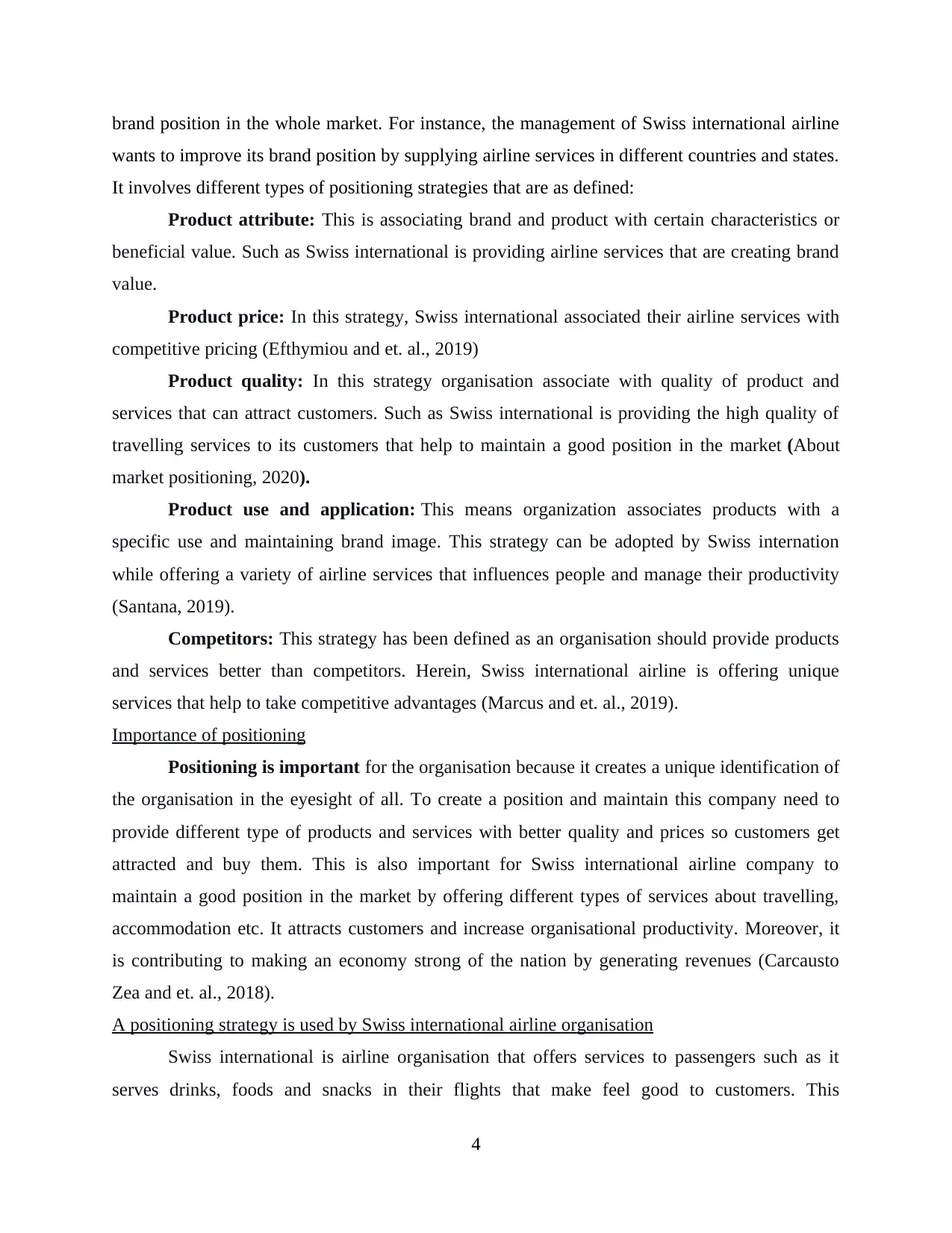
brand position in the whole market. For instance, the management of Swiss international airline
wants to improve its brand position by supplying airline services in different countries and states.
It involves different types of positioning strategies that are as defined:
Product attribute: This is associating brand and product with certain characteristics or
beneficial value. Such as Swiss international is providing airline services that are creating brand
value.
Product price: In this strategy, Swiss international associated their airline services with
competitive pricing (Efthymiou and et. al., 2019)
Product quality: In this strategy organisation associate with quality of product and
services that can attract customers. Such as Swiss international is providing the high quality of
travelling services to its customers that help to maintain a good position in the market (About
market positioning, 2020).
Product use and application: This means organization associates products with a
specific use and maintaining brand image. This strategy can be adopted by Swiss internation
while offering a variety of airline services that influences people and manage their productivity
(Santana, 2019).
Competitors: This strategy has been defined as an organisation should provide products
and services better than competitors. Herein, Swiss international airline is offering unique
services that help to take competitive advantages (Marcus and et. al., 2019).
Importance of positioning
Positioning is important for the organisation because it creates a unique identification of
the organisation in the eyesight of all. To create a position and maintain this company need to
provide different type of products and services with better quality and prices so customers get
attracted and buy them. This is also important for Swiss international airline company to
maintain a good position in the market by offering different types of services about travelling,
accommodation etc. It attracts customers and increase organisational productivity. Moreover, it
is contributing to making an economy strong of the nation by generating revenues (Carcausto
Zea and et. al., 2018).
A positioning strategy is used by Swiss international airline organisation
Swiss international is airline organisation that offers services to passengers such as it
serves drinks, foods and snacks in their flights that make feel good to customers. This
4
wants to improve its brand position by supplying airline services in different countries and states.
It involves different types of positioning strategies that are as defined:
Product attribute: This is associating brand and product with certain characteristics or
beneficial value. Such as Swiss international is providing airline services that are creating brand
value.
Product price: In this strategy, Swiss international associated their airline services with
competitive pricing (Efthymiou and et. al., 2019)
Product quality: In this strategy organisation associate with quality of product and
services that can attract customers. Such as Swiss international is providing the high quality of
travelling services to its customers that help to maintain a good position in the market (About
market positioning, 2020).
Product use and application: This means organization associates products with a
specific use and maintaining brand image. This strategy can be adopted by Swiss internation
while offering a variety of airline services that influences people and manage their productivity
(Santana, 2019).
Competitors: This strategy has been defined as an organisation should provide products
and services better than competitors. Herein, Swiss international airline is offering unique
services that help to take competitive advantages (Marcus and et. al., 2019).
Importance of positioning
Positioning is important for the organisation because it creates a unique identification of
the organisation in the eyesight of all. To create a position and maintain this company need to
provide different type of products and services with better quality and prices so customers get
attracted and buy them. This is also important for Swiss international airline company to
maintain a good position in the market by offering different types of services about travelling,
accommodation etc. It attracts customers and increase organisational productivity. Moreover, it
is contributing to making an economy strong of the nation by generating revenues (Carcausto
Zea and et. al., 2018).
A positioning strategy is used by Swiss international airline organisation
Swiss international is airline organisation that offers services to passengers such as it
serves drinks, foods and snacks in their flights that make feel good to customers. This
4
Paraphrase This Document
Need a fresh take? Get an instant paraphrase of this document with our AI Paraphraser
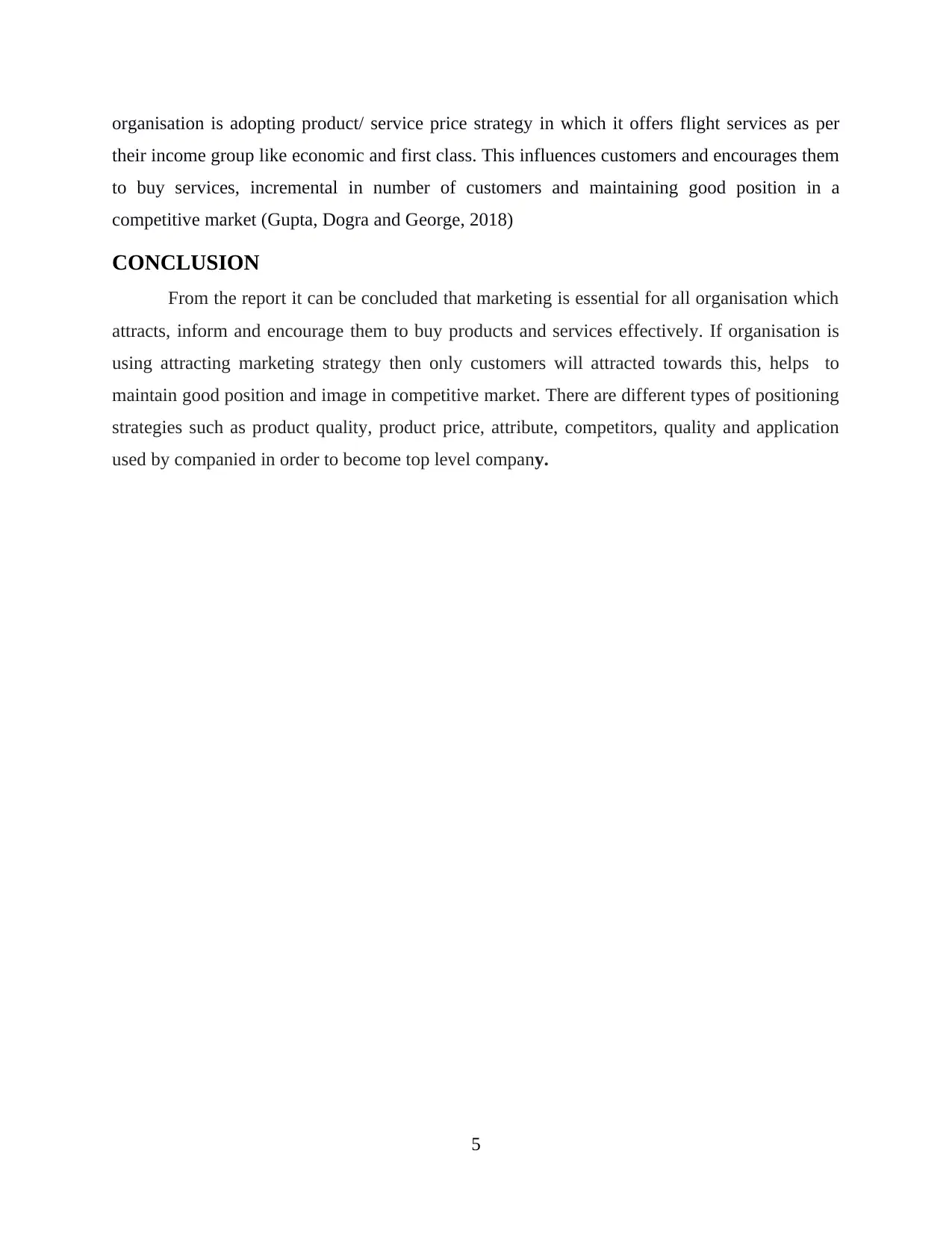
organisation is adopting product/ service price strategy in which it offers flight services as per
their income group like economic and first class. This influences customers and encourages them
to buy services, incremental in number of customers and maintaining good position in a
competitive market (Gupta, Dogra and George, 2018)
CONCLUSION
From the report it can be concluded that marketing is essential for all organisation which
attracts, inform and encourage them to buy products and services effectively. If organisation is
using attracting marketing strategy then only customers will attracted towards this, helps to
maintain good position and image in competitive market. There are different types of positioning
strategies such as product quality, product price, attribute, competitors, quality and application
used by companied in order to become top level company.
5
their income group like economic and first class. This influences customers and encourages them
to buy services, incremental in number of customers and maintaining good position in a
competitive market (Gupta, Dogra and George, 2018)
CONCLUSION
From the report it can be concluded that marketing is essential for all organisation which
attracts, inform and encourage them to buy products and services effectively. If organisation is
using attracting marketing strategy then only customers will attracted towards this, helps to
maintain good position and image in competitive market. There are different types of positioning
strategies such as product quality, product price, attribute, competitors, quality and application
used by companied in order to become top level company.
5
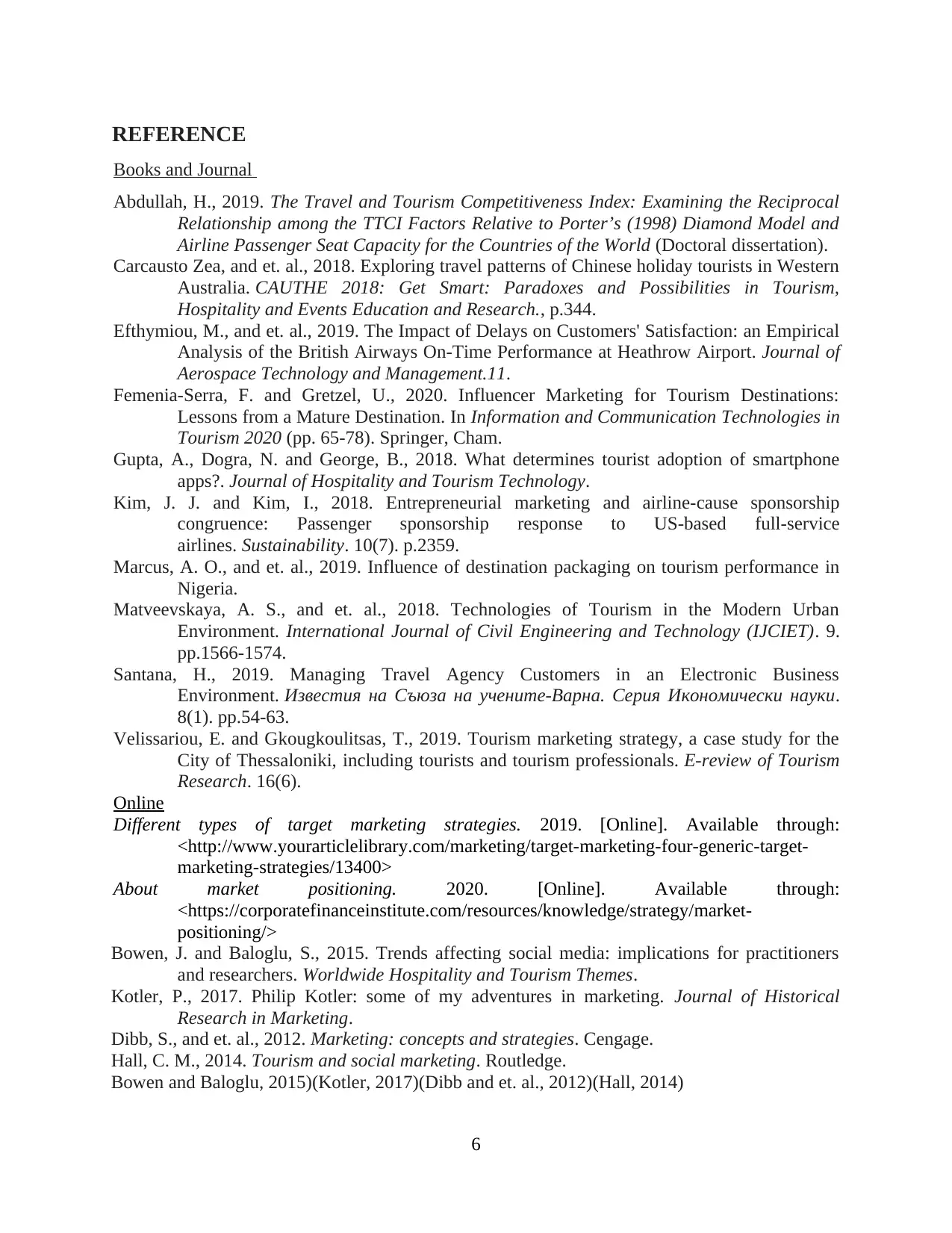
REFERENCE
Books and Journal
Abdullah, H., 2019. The Travel and Tourism Competitiveness Index: Examining the Reciprocal
Relationship among the TTCI Factors Relative to Porter’s (1998) Diamond Model and
Airline Passenger Seat Capacity for the Countries of the World (Doctoral dissertation).
Carcausto Zea, and et. al., 2018. Exploring travel patterns of Chinese holiday tourists in Western
Australia. CAUTHE 2018: Get Smart: Paradoxes and Possibilities in Tourism,
Hospitality and Events Education and Research., p.344.
Efthymiou, M., and et. al., 2019. The Impact of Delays on Customers' Satisfaction: an Empirical
Analysis of the British Airways On-Time Performance at Heathrow Airport. Journal of
Aerospace Technology and Management.11.
Femenia-Serra, F. and Gretzel, U., 2020. Influencer Marketing for Tourism Destinations:
Lessons from a Mature Destination. In Information and Communication Technologies in
Tourism 2020 (pp. 65-78). Springer, Cham.
Gupta, A., Dogra, N. and George, B., 2018. What determines tourist adoption of smartphone
apps?. Journal of Hospitality and Tourism Technology.
Kim, J. J. and Kim, I., 2018. Entrepreneurial marketing and airline-cause sponsorship
congruence: Passenger sponsorship response to US-based full-service
airlines. Sustainability. 10(7). p.2359.
Marcus, A. O., and et. al., 2019. Influence of destination packaging on tourism performance in
Nigeria.
Matveevskaya, A. S., and et. al., 2018. Technologies of Tourism in the Modern Urban
Environment. International Journal of Civil Engineering and Technology (IJCIET). 9.
pp.1566-1574.
Santana, H., 2019. Managing Travel Agency Customers in an Electronic Business
Environment. Известия на Съюза на учените-Варна. Серия Икономически науки.
8(1). pp.54-63.
Velissariou, E. and Gkougkoulitsas, T., 2019. Tourism marketing strategy, a case study for the
City of Thessaloniki, including tourists and tourism professionals. E-review of Tourism
Research. 16(6).
Online
Different types of target marketing strategies. 2019. [Online]. Available through:
<http://www.yourarticlelibrary.com/marketing/target-marketing-four-generic-target-
marketing-strategies/13400>
About market positioning. 2020. [Online]. Available through:
<https://corporatefinanceinstitute.com/resources/knowledge/strategy/market-
positioning/>
Bowen, J. and Baloglu, S., 2015. Trends affecting social media: implications for practitioners
and researchers. Worldwide Hospitality and Tourism Themes.
Kotler, P., 2017. Philip Kotler: some of my adventures in marketing. Journal of Historical
Research in Marketing.
Dibb, S., and et. al., 2012. Marketing: concepts and strategies. Cengage.
Hall, C. M., 2014. Tourism and social marketing. Routledge.
Bowen and Baloglu, 2015)(Kotler, 2017)(Dibb and et. al., 2012)(Hall, 2014)
6
Books and Journal
Abdullah, H., 2019. The Travel and Tourism Competitiveness Index: Examining the Reciprocal
Relationship among the TTCI Factors Relative to Porter’s (1998) Diamond Model and
Airline Passenger Seat Capacity for the Countries of the World (Doctoral dissertation).
Carcausto Zea, and et. al., 2018. Exploring travel patterns of Chinese holiday tourists in Western
Australia. CAUTHE 2018: Get Smart: Paradoxes and Possibilities in Tourism,
Hospitality and Events Education and Research., p.344.
Efthymiou, M., and et. al., 2019. The Impact of Delays on Customers' Satisfaction: an Empirical
Analysis of the British Airways On-Time Performance at Heathrow Airport. Journal of
Aerospace Technology and Management.11.
Femenia-Serra, F. and Gretzel, U., 2020. Influencer Marketing for Tourism Destinations:
Lessons from a Mature Destination. In Information and Communication Technologies in
Tourism 2020 (pp. 65-78). Springer, Cham.
Gupta, A., Dogra, N. and George, B., 2018. What determines tourist adoption of smartphone
apps?. Journal of Hospitality and Tourism Technology.
Kim, J. J. and Kim, I., 2018. Entrepreneurial marketing and airline-cause sponsorship
congruence: Passenger sponsorship response to US-based full-service
airlines. Sustainability. 10(7). p.2359.
Marcus, A. O., and et. al., 2019. Influence of destination packaging on tourism performance in
Nigeria.
Matveevskaya, A. S., and et. al., 2018. Technologies of Tourism in the Modern Urban
Environment. International Journal of Civil Engineering and Technology (IJCIET). 9.
pp.1566-1574.
Santana, H., 2019. Managing Travel Agency Customers in an Electronic Business
Environment. Известия на Съюза на учените-Варна. Серия Икономически науки.
8(1). pp.54-63.
Velissariou, E. and Gkougkoulitsas, T., 2019. Tourism marketing strategy, a case study for the
City of Thessaloniki, including tourists and tourism professionals. E-review of Tourism
Research. 16(6).
Online
Different types of target marketing strategies. 2019. [Online]. Available through:
<http://www.yourarticlelibrary.com/marketing/target-marketing-four-generic-target-
marketing-strategies/13400>
About market positioning. 2020. [Online]. Available through:
<https://corporatefinanceinstitute.com/resources/knowledge/strategy/market-
positioning/>
Bowen, J. and Baloglu, S., 2015. Trends affecting social media: implications for practitioners
and researchers. Worldwide Hospitality and Tourism Themes.
Kotler, P., 2017. Philip Kotler: some of my adventures in marketing. Journal of Historical
Research in Marketing.
Dibb, S., and et. al., 2012. Marketing: concepts and strategies. Cengage.
Hall, C. M., 2014. Tourism and social marketing. Routledge.
Bowen and Baloglu, 2015)(Kotler, 2017)(Dibb and et. al., 2012)(Hall, 2014)
6
⊘ This is a preview!⊘
Do you want full access?
Subscribe today to unlock all pages.

Trusted by 1+ million students worldwide
1 out of 9
Related Documents
Your All-in-One AI-Powered Toolkit for Academic Success.
+13062052269
info@desklib.com
Available 24*7 on WhatsApp / Email
![[object Object]](/_next/static/media/star-bottom.7253800d.svg)
Unlock your academic potential
Copyright © 2020–2025 A2Z Services. All Rights Reserved. Developed and managed by ZUCOL.





